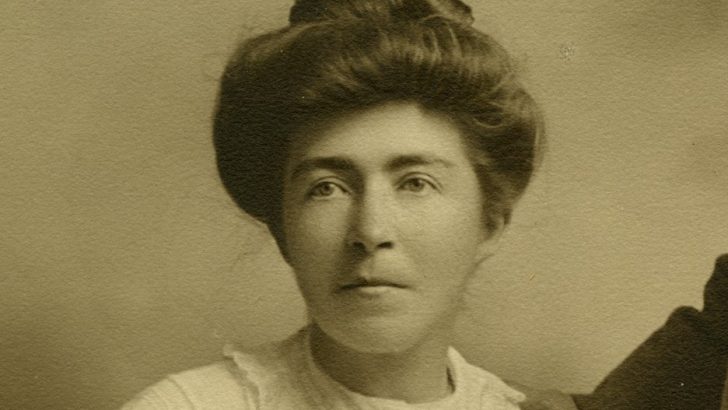Summer outings (No.1 in a six-part series)
For much of her life Hanna Sheehy-Skeffington toiled not only as political publicist, but as a working journalist. She also wrote many non-political articles for magazines and papers which reveal her true skills as a writer.
These now forgotten pieces are often quite charming, filled with insights into other sides of her personality. This account of a summer in Sligo (reprinted here from the Irish Press in 1935), has been slightly edited for length. It will remind us, at this difficult period, of a time when travel in Ireland was easier and more enjoyable than it sometimes is today…
The Killarney of the West
It is invidious, ungracious, to compare beauty spots, or to attempt to assess their relative merits – one should have a heart big enough to embrace all, and be thankful. Therefore, while we hail Sligo as ‘the Killarney of the West’, because it has through Lough Gill many points of resemblance with our best-known, world-famous Killar-ney, Gill has features of its own, a beauty less exotic, more austere; air less softly southern, but more ex-hilarating; landscape less tropical, but touched with that magic dear to painters, the grey-green colouring that marks the West.
Sligo is the centre of a circle of places worth visiting, therefore an ideal stopping place for the holiday-maker. It lies, like Dublin, ringed round by a belt of mountains, but here the Atlantic Ocean completes the girdle.
Distinctive
Bare are these western hills, with a dust of green and with deep scars along their faces, bold and distinctive in outline, Benbulben, among the youngest geologically— a mere 3,000 years or so – Benbulben, clear-cut, with its plateau top, Knocknaree, with its cairn and rounded summit, fitting memorial to Queen Maeve, who shares locally the legendary honours with Granuaile.
Sligo itself is a most interesting place, an ancient city, once the Western cockpit in the long struggle between Irish native and English invader, with its fine harbour, its broad river, the Sligeach, which gives the town its name, linking it with Lough Gill; its tall warehouses, its grey monastic buildings, its winding streets, where one catches unexpectedly many a lovely vista.
Here are alpine plants by Glencar water-fall and rare ferns and mosses”
Not far from the town is a monument of remote anti-quity called ‘The Irish Stonehenge’, the great stone monument, Leaght Conmic-Ruis, called after Con, son of Ruis. Here are abbeys, cromlechs, dolmens, cathe-drals, round towers, carved crosses, pillar stones; joys for antiquarians.
Here are alpine plants by Glencar water-fall and rare ferns and mosses, the hills around rich in treasure for the botanist (on Lough Gill’s shores the wild arbutus grows, once wrongly supposed to be peculiar to Killarney), holy stones, holy wells, in short, all the characteristic features that visitors look for in Irish beauty spots – and withal, a gentle, courteous people, welcoming the stranger with old-world charm and dignity.
For Sligonians (I hope that is the correct form), Lough Gill takes the place of Killarney’s lakes: indeed, there are those who prefer it. Certainly, Sligo folk love their lake at all seasons, pouring out there to row, to fish, to sail, to picnic on its many wooded isles on every conceivable occasion.
If you love the less beaten track and are not afraid of walking, there is Glencar waterfall”
You can walk around the lake, if you prefer to view it thoroughly from the shore, though in parts the going may be rough. In the season local cruisers run pleasure-trips to Lough Gill up the Sligo river every Sunday afternoon.
I recall my first acquaintance many years ago, through fiction, with the beauties of Lough Gill in a now old-fashioned novel, still readable, The Wild Rose of Lough Gill. Sligo still reads it, for I noted it in local book-shops and libraries side by side with books on Countess Markievicz and Yeats’ poetry.
If you love the less beaten track and are not afraid of walking, there is Glencar waterfall, in its wooded dell, or the slopes of old Benbulben, or the O’Rourke country, or Drumohaire in neighbouring Leitrim, or Ballysodaire. Here is the valley which Moore sings of in his plaintive The Valley Lay Smiling Before Me, linked with the story of O’Rourke, Prince of Breffny, whose name is still remembered here, and whose exploits are the theme of many a fireside tale.
So, whether you love old times or new or whether, wiser still, you can enjoy the flavour of both, Sligo has a choice to offer.
More on The Wild Rose
A note on The Wild Rose of Lough Gill. Set in the years of turmoil following 1641, The Wild Rose of Lough Gill (Gill, 1883), was said to be one of the most popular novels ever published in Ireland, with a first printing of 2,000 copies.
The strife-torn Ireland of Owen Roe O’Neill is the setting for this haunting story of Edmund O’Tracy and Kathleen, his ‘Wild Rose’, the two young lovers caught in the terrible events of the age.
This rousing tale, akin in some way to Manzoni’s great novel I Promessi Sposi, ends shortly after the fall of Galway, but the scene is set partly around Lough Gill.
Patrick G. Smyth was born in Ballina, Co. Mayo. Besides his novels he wrote poetry for several Irish periodicals between 1876 and 1885. He emigrated to America in 1889 where he worked on a Chicago news-paper.
There is a passing reference to him at a New York wedding in 1892, but his date of death is unknown.
‘The Wild Rose’ is now the name of a yearly festival held in Manorhamilton, Leitrim. This year’s event has been cancelled, but the committee promises it will be back in 2021.


 Peter Costello
Peter Costello Hanna Sheehy-Skeffington
Hanna Sheehy-Skeffington 
